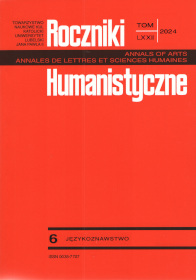STRESZCZANIE RĘCZNE A STRESZCZENIE AUTOMATYCZNE TEKSTU NAUKOWEGO –STUDIUM PRZYPADKU
Manual Summarization Versus Automatic Summarization of a Scientific Text: A Case Study
Author(s): Monika ŁaszkiewiczSubject(s): Language and Literature Studies, Studies of Literature
Published by: Towarzystwo Naukowe KUL & Katolicki Uniwersytet Lubelski Jana Pawła II
Keywords: summary; human summarization; automatic summarization; machine summarization
Summary/Abstract: The purpose of the article was to compare summaries of the same text – a scientific article by Jerzy Bartmiński titled “Colloquial Style”. Thirty-five abstracts were made by hand, five were the result of machine summarization (Resoomer, Smodin, ChatGPT were used). During the analysis, it was noted that the abstracts prepared by hand met the requirement of informativeness, but its degree is individualized – depending on the competence of the author. These abstracts more accurately identified key elements of the content and more effectively avoided the inclusion of secondary information. ChatGPT managed to do this to a lesser extent, but the results obtained provide insight into the content of the article. The summary obtained with Resoomer requires additional human work (additions, editing). The result of the Smodin tool can hardly be considered a text. Each of the manual summaries is different, as are the summaries generated by ChatGPT. The abstracts generated by Resoomer and Smodin are always the same. Thus, one can see some similarity in modern automatic summarization to the traditional way of summarizing by humans (or even different humans), who are able to generate different, correct summaries of the same text.
Journal: Roczniki Humanistyczne
- Issue Year: 72/2024
- Issue No: 6
- Page Range: 153-166
- Page Count: 14
- Language: Polish

